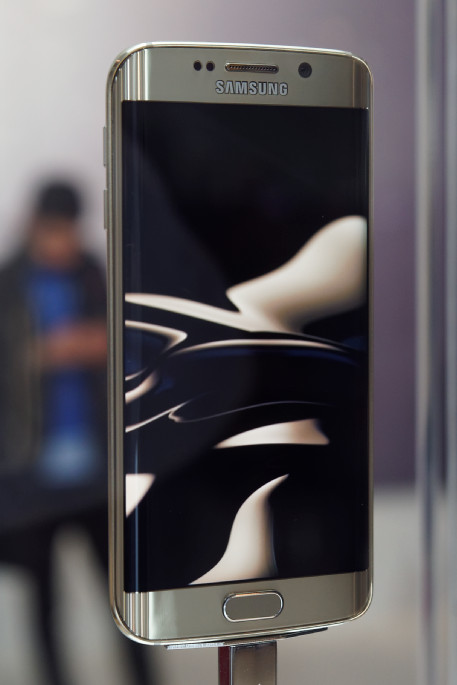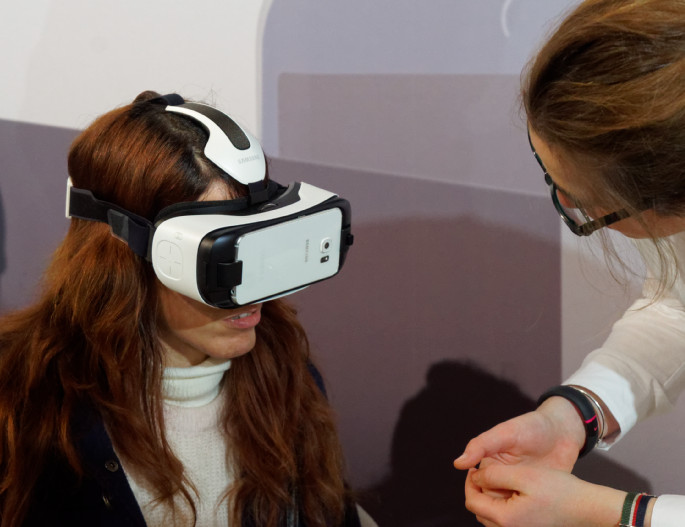Samsung held its “Unpacked 2015” event at the Barcelona Conference Centre on the evening before the show proper opened. It was a big event – with many partners and Samsung staff as well as a lot of media from around the world. The number of attendees would have been in the thousands.
The big announcement was of the “next galaxy” smartphone – but the presentation was preceded by a long and detailed written disclaimer about the specifications and comparisons shown.
Young Hee Lee was the first person and the main presenter and she introduced JK Shin – CEO of Samsung who said that, now, there were no more rumours. He said that Samsung had tried to follow a simple philosophy – that of relentless innovation and he joked that his English might be weak as his first language is engineering.
Shin said that some companies differentiate by design, others by technology and Samsung wants to do both. It wants to create the “most beautiful and advanced smartphones”.
As we know now, there were two new phones the Galaxy S6 and the S6 Edge which has two curved edges. Big news for us is that the resolution has gone up from FullHD to 2560 x 1440 (4 megapixels/QuadHD). This means that the 5.1″ AMOLED display (the same size as the S5) has 577 ppi.
There is a new and fast CPU, Shin said with a camera with a fast lens at F1.9 and the phone has powerful security.
Some months ago, Samsung bought LoopPay and the S6 includes the technology that it acquired which will be marketed as Samsung Pay. Shin believes that the new phone will significantly increase the number of payments for merchants and consumers as the technology can even be used on magnetic stripe card readers.
Of course, the value of a smartphone depends on connectivity so the new phone is said to have “the fastest LTE”. The phone also has wireless charging built in. This supports both the inductive charging standards (WPC and PMA) that are in the market (although it doesn’t support the resonant technology, which was certainly getting a lot of support on the show floor).

The Edge is the first smartphone to have a dual curved glass down each side and Shin said that this was tricky to engineer, it apparently takes work at 800 deg C to curve the glass. Shin believes that the feature will deliver a “Good viewing experience, a comfortable grip and envy from friends”. Glass is used on the back and has a special layer for the gold/platinum effect and the phone will also be available in “white pearl” and black.
Both models use Gorilla Glass 4 – “the toughest in market” and this is backed up by 50% stronger metal than “other high end phones” – “This phone won’t bend”, said Lee for which he got a good response!
Turning to the inside of the phone, Hyun Yeul Lee said that there is a new interface to make it simpler. There are fewer notifications – smaller menus are used and operation has been streamlined – text is used in addition to and rather than just icons. Parts of the phone’s system are colour coded – for example, functions related to the phone are green while orange is used for contacts. On the edge phone, colours can be assigned to particular users so that the edge can glow to identify who is calling.
If the phone has been put down the fingerprint detector (which doesn’t need stroking like previous ones) on the back allows users to send a message – “I’m in a meeting and will call you when I’m out of the meeting”.
The processor is an 8 core 64 bit device that is built using 14nm technology which Samsung says boosts processing power by 20% while reducing the electrical power used by 35%. For the new phones, Samsung has developed eMMC flash storage – this is said to be faster than SSD or mobile flash and helps to boost device performance.
To go with the new phone, there is a new Gear VR headmount system for VR applications – the higher pixel density is said to give a better experience (although we didn’t think it was that good).
 A significant change is a fixed battery for the new processor – but Samsung said that the new battery charges faster than any others. It takes just 10 mins to get enough charge for 4 hours use, the firm said. To applause, Samsung also claimed that the battery reaches 100% in half the time of the iPhone 6.
A significant change is a fixed battery for the new processor – but Samsung said that the new battery charges faster than any others. It takes just 10 mins to get enough charge for 4 hours use, the firm said. To applause, Samsung also claimed that the battery reaches 100% in half the time of the iPhone 6.
There was a lot of emphasis on the camera – the presenter said that all the video for presentation was captured on the smartphone. The camera is said to be very good at low light. As well as the F1.9 lens it has a “real time HDR” low light shot mode – and that’s on the front camera – which has 5 megapixels – and those pixels are said to be 43% larger. The back camera has 16 megapixels and also has good low light performance. The company showed images that were taken on the iPhone 6 and also on the S6 to highlight the better low light performance.
Assuming that Samsung was being honest, the performance was impressively different.
To make it easier to catch shots, the S6 camera is “always on standby” – it takes less than 1 sec to start up. The camera has a fast tracking Autofocus system with “object focus” which means that the image is analysed to detect objects and then maintains the focus.
Turning to Pay, universality is critical – only 10% of merchants in the US have NFC, as used by Apple. On the other hand, Samsung Pay can be used “anywhere” that accepts cards or NFC. As mentioned earlier, the pay technology, which is protected by fingerprint authentication, can be used in 95% of locations. Supporters that Samsung quoted included: MasterCard, Visa, Amex, Bank of America, Chase, Citi, USBank, First Data and Synchrony
Finally turning to security, the firm said that Knox security is built in.
Analyst Comment
Clearly, the new phone is a nicer device than the last one, but it didn’t seem “relentlessly innovative”. Personally, I like the replacement battery possibilities of previous phones – I carry a big battery and spare back for days when I know I’m going to be using my phone a lot and won’t have a chance to charge it. Still, I’ll just have to carry one of the many battery-based phone chargers that I have been given over the years. Samsung upset a few people in its “thanks for coming” gift. The bag contained a box that was big enough and heavy enough to have contained a phone. However, it just had a very heavy duty charger! The general view at the event was that without changing to a fixed battery, there was no way for the phone to be “thinner than an iPhone”.
The event was quite well presented – there were 24 projectors – 10 double stacked around two thirds of the walls, with four covering maybe another 15%, so for some of the presentations, perhaps 85% of the walls around the auditorium were illuminated, although only the front ones carried high information content. The Samsung press “hands on” was very busy
The Samsung press “hands on” was very busy
After the presentations we got a chance to queue up to handle the phones. The interface looks cleaner and is quite snappy. I think I quite like the Edge version, although I can imagine that sometimes the curves on the edges might just make the display look a bit distorted. (BR)

